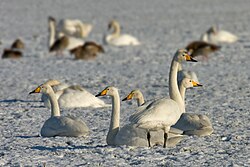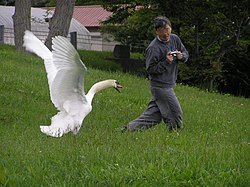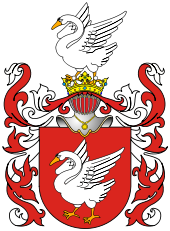Swan
| Swans | |
|---|---|
 | |
| Mute Swans (Cygnus olor) | |
| Scientific classification | |
| Kingdom: | Animalia |
| Phylum: | Chordata |
| Class: | Aves |
| Order: | Anseriformes |
| Family: | Anatidae |
| Subfamily: | Anserinae |
| Tribe: | Cygnini Vigors, 1825 |
| Genus: | Cygnus Garsault, 1764 |
| Species | |
6–7 living, see text.
| |
| Synonyms | |
Cygnanser Kretzoi, 1957
| |
Swans, genus Cygnus, are birds of the family Anatidae, which also includes geese and ducks. Swans are grouped with the closely related geese in the subfamily Anserinae where they form the tribe Cygnini. Sometimes, they are considered a distinct subfamily, Cygninae. There are six to seven species of swan in the genus Cygnus; in addition there is another species known as the Coscoroba Swan, although this species is no longer considered related to the true swans. Swans usually mate for life, though 'divorce' does sometimes occur, particularly following nesting failure. The number of eggs in each clutch ranges from three to eight.
Etymology and terminology
The word swan is derived from Old English swan, akin to the German Schwan and Dutch zwaan and Swedish svan, in turn derived from Indo-European root *swen (to sound, to sing). Young swans are known as swanlings or as cygnets, from Greek κύκνος, kýknos and from the Latin word cygnus ("swan") and the Old French suffix -et ("little"). An adult male is a cob, from Middle English cobbe (leader of a group); an adult female is a pen.
Description
The swans are the largest members of the duck family Anatidae, and are among the largest flying birds. The largest species, including the mute swan, trumpeter swan, and whooper swan, can reach length of over 1.5 m (60 inches) and weigh over 15 kg (33 pounds). Their wingspans can be almost 3 m (10 ft). Compared to the closely related geese they are much larger in size and have proportionally larger feet and necks. They also have a patch of unfeathered skin between the eyes and bill in adults. The sexes are alike in plumage, but males are generally bigger and heavier than females.
The Northern Hemisphere species of swan have pure white plumage but the Southern Hemisphere species are mixed black and white. The Australian Black Swan (Cygnus atratus) is completely black except for the white flight feathers on its wings; the chicks of black swans are light grey in colour, and the South American Black-necked Swan has a black neck.
The legs of swans are normally a dark blackish grey colour, except for the two South American species, which have pink legs. Bill colour varies: the four subarctic species have black bills with varying amounts of yellow, and all the others are patterned red and black. Although most birds generally do not have teeth, swans are known to be an exception to this, having small jagged 'teeth' as part of their beaks used for catching and eating fish. The Mute Swan and Black-necked Swan have a lump at the base of the bill on the upper mandible.
Distribution and movements
The swans are generally found in temperate environments, rarely occurring in the tropics. A group of swans is called a bevy or a wedge in flight. Four (or five) species occur in the Northern Hemisphere, one species is found in Australia and New Zealand and one species is distributed in southern South America. They are absent from tropical Asia, Central America, northern South America and the entirety of Africa. One species, the Mute Swan, has been introduced to North America, Australia and New Zealand.
Several species are migratory, either wholly or partly so. The Mute Swan is a partial migrant, being resident over areas of Western Europe but wholly migratory in Eastern Europe and Asia. The Whooper Swan and Tundra Swan are wholly migratory, and the Trumpeter Swans are almost entirely migratory. There is some evidence that the Black-necked Swan is migratory over part of its range, but detailed studies have not established whether these movements are long or short range migration.
Behaviour
Swans feed in the water and on land. They are almost entirely herbivorous, although they may eat small amounts of aquatic animals. In the water food is obtained by up-ending or dabbling, and their diet is composed of the roots, tubers, stems and leaves of aquatic and submerged plants.
Swans form socially monogamous pair bonds that last for many years, and in some cases these can last for life. These bonds are maintained year round, even in gregarious and migratory species like the Tundra Swan, which congregate in large flocks in the wintering grounds. The nest is on the ground near water and about a metre across. Unlike many other ducks and geese the male helps with the nest construction. Average egg size (for the mute swan) is 113×74 mm, weighing 340 g, in a clutch size of 4 to 7, and an incubation period of 34–45 days. With the exception of the whistling ducks they are the only anatids where the males aid in incubating the eggs.
Systematics and evolution
All evidence suggests that the genus Cygnus evolved in Europe or western Eurasia during the Miocene, spreading all over the Northern Hemisphere until the Pliocene. When the southern species branched off is not known. The Mute Swan apparently is closest to the Southern Hemisphere Cygnus (del Hoyo et al., eds, Handbook of the Birds of the World); its habits of carrying the neck curved (not straight) and the wings fluffed (not flush) as well as its bill color and knob indicate that its closest living relative is actually the Black Swan. Given the biogeography and appearance of the subgenus Olor it seems likely that these are of a more recent origin, as evidence shows by their modern ranges (which were mostly uninhabitable during the last ice age) and great similarity between the taxa.
Genus Cygnus:
- Subgenus Cygnus
- Mute Swan, Cygnus olor, is a Eurasian species that occurs at lower latitudes than Whooper Swan and Bewick's Swan across Europe into southern Russia, China and the Russian Maritimes. Recent fossil records, according to the British Ornithological Union, showCygnus olor is among the oldest bird species still extant and it has been upgraded to "native" species in several European countries, since this bird has been found in fossil and bog specimens dating back thousands of years. Common temperate Eurasian species, often semi-domesticated; descendants of domestic flocks are naturalized in the United States and elsewhere.
- Subgenus Chenopis
- Black Swan, Cygnus atratus of Australia, and introduced in New Zealand.
- New Zealand Swan, Cygnus atratus sumnerensis, an extinct subspecies of the Black Swan from New Zealand and the Chatham Islands.
- Black Swan, Cygnus atratus of Australia, and introduced in New Zealand.
- Subgenus Sthenelides
- Black-necked Swan, Cygnus melancoryphus of South America.
- Subgenus Olor
- Whooper Swan, Cygnus cygnus breeds in Iceland and subarctic Europe and Asia, migrating to temperate Europe and Asia in winter.
- Trumpeter Swan, Cygnus buccinator is the largest North American swan. Very similar to the Whooper Swan (and sometimes treated as a subspecies of it), it was hunted almost to extinction but has since recovered.
- Tundra Swan, Cygnus columbianus is a small swan which breeds on the North American tundra, further north than Trumpeter Swan. It winters in the USA.
- Bewick's Swan, Cygnus (columbianus) bewickii is the Eurasian form which migrates from Arctic Russia to western Europe and eastern Asia (China, Japan) in winter. It is often considered a subspecies of C. columbianus, creating the species Tundra Swan.
The fossil record of the genus Cygnus is quite impressive, although allocation to the subgenera is often tentative; as indicated above, at least the early forms probably belong to the C. olor - Southern Hemisphere lineage, whereas the Pleistocene taxa from North America would be placed in Olor. A number of prehistoric species have been described, mostly from the Northern Hemisphere. Among them was the giant Siculo-Maltese C. falconeri which was taller (though not heavier) than the contemporary local dwarf elephants (Elephas falconeri).
Fossil swans
- Cygnus csakvarensis (Late Miocene of Hungary) - formerly Cygnanser
- Cygnus mariae (Early Pliocene of Wickieup, USA)
- Cygnus verae (Early Pliocene of Sofia, Bulgaria)
- Cygnus liskunae (Middle Pliocene of W Mongolia)
- Cygnus hibbardi (?Early Pleistocene of Idaho, USA)
- Cygnus sp. (Early Pleistocene of Dursunlu, Turkey: Louchart et al. 1998)
- Giant Swan, Cygnus falconeri (Middle Pleistocene of Malta and Sicily, Mediterranean)
- Cygnus paloregonus (Middle Pleistocene of WC USA) - includes "Anser" condoni and C. matthewi
- Dwarf Swan Cygnus equitum (Middle - Late Pleistocene of Malta and Sicily, Mediterranean)
- Cygnus lacustris (Late Pleistocene of Lake Eyre region, Australia) - formerly Archaeocygnus
- Cygnus sp. (Pleistocene of Australia)
The supposed fossil swans "Cygnus" bilinicus and "Cygnus" herrenthalsi were, respectively, a stork and some large bird of unknown affinity (due to the bad state of preservation of the referred material). Anser atavus is sometimes placed in Cygnus.
The Coscoroba Swan (Coscoroba coscoroba) from South America, the only species of its genus, is apparently not a true swan. Its phylogenetic position is not fully resolved; it is in some aspects more similar to geese and shelducks.
Role in culture
Swan meat has been regarded as a luxury food in England since at least the reign of Elizabeth I. A recipe for baked swan survives from that time. "To bake a Swan Scald it and take out the bones, and parboil it, then season it very well with Pepper, Salt and Ginger, then lard it, and put it in a deep Coffin of Rye Paste with store of Butter, close it and bake it very well, and when it is baked, fill up the Vent-hole with melted Butter, and so keep it; serve it in as you do the Beef-Pie."
Many of the cultural aspects refer to the Mute Swan of Europe. Perhaps the best known story about a swan is The Ugly Duckling fairytale. The story centres on a duckling that is mistreated until it becomes evident he is a swan and is accepted into the habitat. He was mistreated because real ducklings are, according to many, more attractive than a cygnet, yet cygnets become swans, which are very attractive creatures. Swans are often a symbol of love or fidelity because of their long-lasting, apparently monogamous relationships. See the famous swan-related operas Lohengrin and Parsifal.
Swans feature strongly in mythology. In Greek mythology, the story of Leda and the Swan recounts that Helen of Troy was conceived in a union of Zeus disguised as a swan and Leda, Queen ofSparta. Other references in classical literature include the belief that upon death the otherwise silent Mute Swan would sing beautifully - hence the phrase swan song; as well as Juvenal's sarcastic reference to a good woman being a "rare bird, as rare on earth as a black swan", from which we get the Latin phrase rara avis, rare bird.
The Irish legend of the Children of Lir is about a stepmother transforming her children into swans for 900 years. In the legend The Wooing of Etain, the king of the Sidhe (subterranean-dwelling, supernatural beings) transforms himself and the most beautiful woman in Ireland, Etain, into swans to escape from the king of Ireland and Ireland's armies. The swan has recently been depicted on an Irish commemorative coin.
In Norse mythology, there are two swans that drink from the sacred Well of Urd in the realm of Asgard, home of the gods. According to the Prose Edda, the water of this well is so pure and holy that all things that touch it turn white, including this original pair of swans and all others descended from them. The poemVolundarkvida, or the Lay of Volund, part of the Poetic Edda, also features swan maidens.
In the Finnish epic Kalevala, a swan lives in the Tuoni river located in Tuonela, the underworld realm of the dead. According to the story, whoever killed a swan would perish as well. Jean Sibelius composed the Lemminkäinen Suite based on Kalevala, with the second piece entitled Swan of Tuonela (Tuonelan joutsen). Today, five flying swans are the symbol of the Nordic Countries and the whooper swan (Cygnus cygnus) is the national bird of Finland.
French writer François Rabelais wrote in Gargantua and Pantagruel that a swan's neck was the best toilet paper he had encountered.
A swan is one of the attributes of St Hugh of Lincoln based on the story of a swan who was devoted to him. In Latin American literature, the Nicaraguan poet Rubén Darío (1867–1916) consecrated the swan as a symbol of artistic inspiration by drawing attention to the constancy of swan imagery in Western culture, beginning with the rape of Leda and ending with Wagner's Lohengrin. Darío's most famous poem in this regard isBlasón - "Coat of Arms" (1896), and his use of the swan made it a symbol for the Modernismo poetic movement that dominated Spanish language poetry from the 1880s until the First World War. Such was the dominance of Modernismo in Spanish language poetry that the Mexican poet Enrique González Martínez attempted to announce the end of Modernismo with a sonnet provocatively entitled, Tuércele el cuello al cisne - "Wring the Swan's Neck" (1910).
Swans are revered in Hinduism, and are compared to saintly persons whose chief characteristic is to be in the world without getting attached to it, just as a swan's feather does not get wet although it is in water. The Sanskrit word for swan is hamsa orhansa, and it is the vehicle of many deities like the goddess Saraswati. It is mentioned several times in the Vedic literature, and persons who have attained great spiritual capabilities are sometimes called Paramahamsa ("Great Swan") on account of their spiritual grace and ability to travel between various spiritual worlds. In the Vedas, swans are said to reside in the summer on Lake Manasarovar and migrate to Indian lakes for the winter. They're believed to possess some powers such as the ability to eat pearls. They are also believed to be able to drink up the milk and leave the water from a saucer of milk adulterated with water. This is taken as a great quality, as shown by this Sanskrit verse:
Hamsah shwetah, bakah shwetah, kah bhedah hamsa bakayo?
Neeraksheera viveketu, Hamsah hamsah, bakah bakah!
(The swan is white, the crane is white, so how to differentiate between both of them?
With the milk-water test, the swan is proven swan, the crane is proven crane!)
Hindu iconography typically shows the Mute Swan. It is wrongly supposed by many historians that the word hamsa only refers to a goose, since today swans are no longer found in India, not even in most zoos. However, ornithological checklists clearly classify several species of swans as vagrant birds in India.
The ballet Swan Lake by Pyotr Tchaikovsky is considered among both the most important works of this composer and among the often-performed classics of ballet. It is partially based on an ancient German legend, which tells the story of Odette, a princess turned into a swan by an evil sorcerer's curse—to which were added similar elements from Russian folk tales. Some major elements (girls turned to swans and living in a lake, and a hero falling in love with one of them) are also shared by the Irish mythology story of Caer Ibormeith.
The 1994 American animated film The Swan Princess is also derived from the same ancient sources, featuring an evil sorcerer who kidnaps a princess named Odette and curses her so that she is a swan by day and a woman by night, until the prince comes to rescue her.
Hans Christian Andersen's tale "The Wild Swans" is similar to the "Children of Lir" story. The king has eleven sons and one daughter, named Elisa. The evil stepmother turns the eleven brothers into swans and banishes Elisa, an interesting exception to the tradition of swan maidens.
The Black Swan is the faunal emblem of the Australian state of Western Australia and swans are featured on the coat of arms of Canberra, the Australian capital.
The Sydney Swans are an Australian rules football team based in Sydney, Australia.









No comments:
Post a Comment